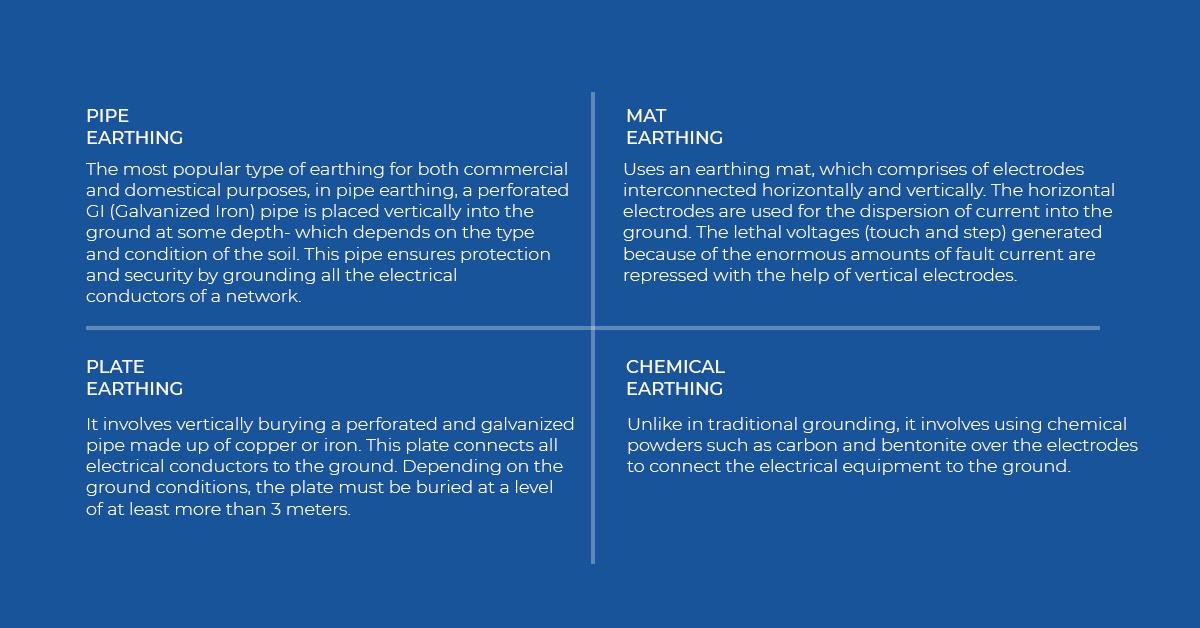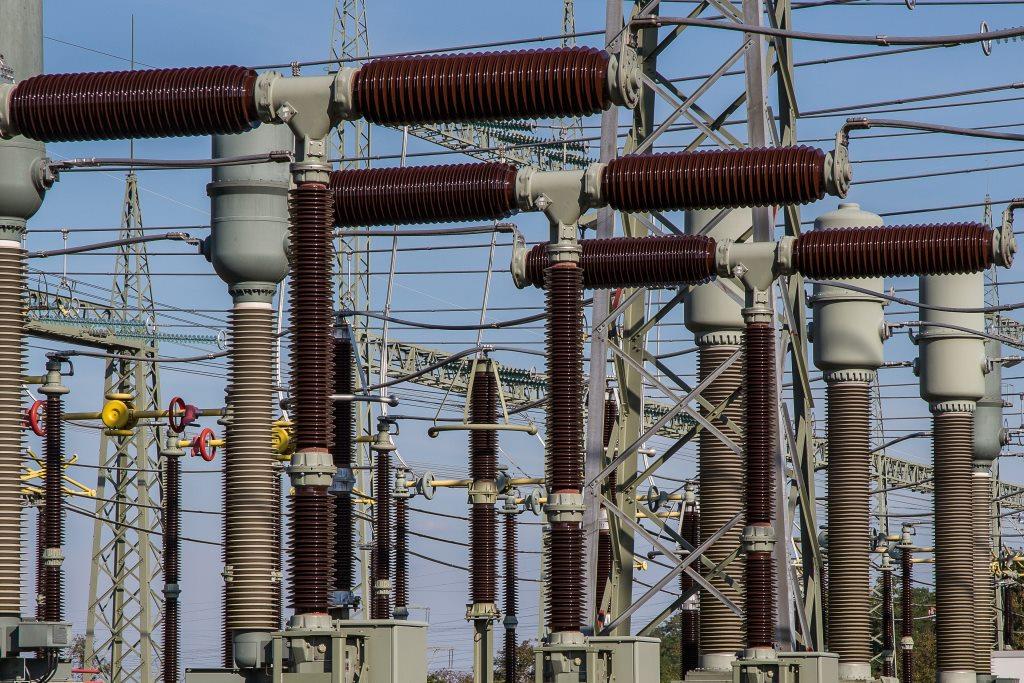Safety is paramount when it comes to laying the groundwork for an establishment’s electrical network. Earthing, also known as grounding, is a fundamental and necessary part of ensuring safety in an electrical system. It helps in protecting people and equipment as it safeguards against dangerous potential differences. This article discusses an earthing system and its types while elucidating their importance in mitigating risks to make electrical networks safe.

Earthing- A Look Behind Its Science:
The primary objective of earthing is to dissipate any excess electrical energy directly into the terrain. It detects the stray voltages and prevents flow of current through a low resistance wire. Fault currents, atmospheric discharges, human error, etc. are some of the reasons for leakage current in an electrical system. It provides a path to such unwanted charge by connecting the non-current carrying part of the equipment to the ground.
Earth’s electric potential is zero, so the electric potential of any charge connected to the ground neutralizes. Thus, grounding provides the current with a shorter direct route into the ground.
Generation of a potential difference in certain points of the infrastructure is common. Therefore, grounding systems guarantees the safety of the people and the installation even if significant potential differences appear.
Importance of Earthing Systems:
Without a doubt, electrical systems are extremely hazardous. However, proper grounding of all metallic parts of the electrical system and equipment helps in preventing the adverse effects, even if there is excessive voltage present, by safely discharging it into the ground. When the system’s insulation fails, it prevents any mishaps from occurring.
Keep in mind that an electric current of 100 mA is considered lethal to the human body, and majority of our household appliances operate at much higher voltages.
Proper earthing becomes necessary for the following reasons:
- It shields personnel from the effects of a short-circuit.
- It provides the easiest path to the flow of short-circuit current even after the failure of the insulation.
- It shields the equipment and personnel from high voltage surges and lightning discharge.
- It prevents the risk of current leakage escalating into an electrical fire.
Unearthed current can harm the entire network. Thus, protecting our electrical networks and the people in contact with the circuit becomes the priority.
Advantages that an Earthing System Provides:
Even though wire insulation is the first line of defence, the unparalleled benefits that earthing provides from a technical perspective have resulted in it becoming a standard procedure in the electrical industry.
- The primary benefit of earthing is current or voltage balancing. The earth is connected to the electrical system’s neutral point. Because the earth’s potential is zero volts, it balances the current and voltage between the three phases.
- It allows businesses to utilize metal in the electric installations without the fear of conductivity. A separate path is provided for faulty current to pass through, allowing its immediate detection and termination.
- In the event of a voltage surge, the sudden overload can damage devices and endanger human life. Through grounding, the current passes through a different path and has no effect on the electrical system.
- An electrical circuit consists of different transformers that may influence and cause reactions with each other, when working simultaneously. The earth’s constant conductive nature helps configure the relationships between various electrical sources and makes them easily manageable.

Is Only Earthing Alone Sufficient?
Sustenance and continuity of business equipment or systems depend upon reliable power services that keep the production running. While power services solely depend upon the efficacy of an earthing system. However, the surrounding system highly affects the effectiveness of an earthing system. It deteriorates over time, and the signs of wear are not detectable prior to failure, without a careful inspection. Thus, a routine earthing study is important to ensure the systems are operating at optimum levels.
Given the high reliability and rhetorical infrastructure, combined with the challenges in the maintenance of an earthing system, in-depth inspection and study are essential while meeting the business requirements. It ensures that businesses’ responsibilities and safety concerns for valuable assets are met.
The main causes of failure of an earthing system include soil resistivity, material degradation, corrosion by stray electricity, and more. Some causes are relatively easy to prevent or mitigate—such as lack of regular maintenance; while others are more difficult to control, such as lightning strikes or pipe corrosion.
During installation, the location of the ground pit, soil resistivity, depth of grounding, etc. play an integral part. Moreover, a regular study ensures that businesses keep a check on such unforeseen conditions. It is a significant factor in determining the optimum potential of the grounding system and how can it remain optimized even after years and years of its usage.
Essentially, the study includes research, testing alternatives, and choice of effective measures as per the business requirements. However, it is challenging to keep a track of all these factors without the assistance of reliable and service providers.
Ground Your Worries: Earthing Study by VNT
Earthing study plays a vital role in the functionality of electrical equipment and structure. It ensures the safety and the longevity of the structure and electrical equipment by monitoring earthing system.
VNT provides an exhaustive, detailed, and trustworthy earthing study for electrical networks. Our services comply with the latest standards and government regulations. We utilize advanced practices and aid the businesses through integrated solutions. This prevents the possibility of any electrical mishaps and ensures the safety of the business’s invaluable assets in long run.
Standards and guidelines followed by VNT’s Earthing Study:
According to The Bureau of Indian Standards and Central Electricity Authority Regulations (CEAR), businesses need to comply with the following codes-
- IS 3034: This standard consolidates the information related to earthing & its study such as design, installation, and inspection & maintenance guidelines. In short, it is concerned with factors like:
- The measurements of the wires, pipes, and plates used in different types of earthing.
- The regulated use of chemicals in chemical earthing.
- The depth of burying ground to secure the earthing plate from damage due to factors like animals, rainwater, etc.
- IEEE 8084: This standard provides information about grounding an outdoor AC substation, either conventional or gas-insulated, i.e., electric grid station. Mainly, it is concerned with factors like:
- Specification of the recommended design features of the given grid. Its safe limits that can exist in the substation even in case of any faults.
- Providing a procedure for designing a safe and practical grounding system based on the requirements of the system.
- Providing various procedures for measuring and treating soil resistivity.
All businesses and establishments must take care of their assets, including the most invaluable assets- their workforce. At VNT, we provide holistic and trustworthy earthing study without neglecting the required code or regulations to maintain the business standard. With a detailed and personalized study, we ensure that each component is the best for your electrical earthing system.
To ground all your worries with VNT’s reliable Earthing Study and have your electrical network up and running safely at all times, contact us.

